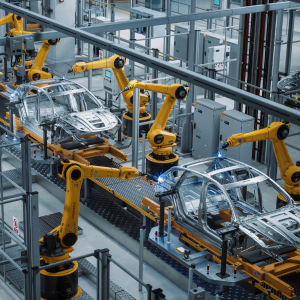Industry 4.0:
RFID In Manufacturing
Post By: Ryan King On: 03-09-2018 - Industry 4.0 - Industry Trends - Manufacturing
Recent developments in technology have enabled more businesses to improve processes, increase productivity and reduce costs. Enterprises are rapidly adopting RFID to help store, transmit and tag objects in a manufacturing line.
What is RFID?
RFID, radio-frequency identification, is a technology where data is encoded on RFID tags or smart labels which can be read by readers using radio waves. When a reader reads the encoded data on the tag/label, the system can then store this information in a database or trigger processes. RFID has several significant advantages over existing asset tagging technologies like barcodes. An RFID tag/label can be read at a distance and without a clear line-of-sight to the tag. This allows the chip to be embedded in the surface of a product or in a discreet location.
The History of RFID
RFID is not a new technology, in fact, it has its roots in a device developed back in 1973 that used a passive radio transponder with 16-bit memory to store information. This was then powered up by an interrogating signal which could read the data. This started numerous developments in the following decades to develop higher capacity tags and reduce the power requirement.
RFID Formats
RFID comes in a variety of formats that are widely used. These formats have different use cases.
- Long-range, one of the most common forms of RFID. Long-range RFID is also known as RAIN RFID which can read tags up to 15 metres away while offering the fastest recognition using the UHF band to operate.
- Vicinity RFID, another common form of RFID read chips at a shorter distance than long-range RFID at 1.2 metres. This format utilises the HF band and is most commonly used with smartphone readers.
How Does RFID Work?
RFID works by utilising radio waves to power a low-power chip, usually in a tag or label, and retrieving the data stored on the integrated storage. RFID systems consist of 3 core components: a tag/label containing an integrated circuit and an antenna, an interrogator also known as the reader and a communications interface which allows a computer to interpret and store the data.
RFID Tags and Labels
There are many forms in which RFID is being integrated including:
- Tags, simple tags which attach to an object.
- Labels, embedded in the paper part of the label, the label can be used to display information printed on them such as a barcode or part information.
- Embedded chips. Some manufacturers are embedding RFID chips and antennas directly into their products.
What is Industry 4.0?
RFID is playing a vital role in the data storage and transmission with the developments of industry 4.0. Industry 4.0 has been coined, the fourth industrial revolution. We have a handy guide which explores what is industry 4.0 and goes into active developments with this trend.

How RFID is Being Used in Manufacturing
With industry 4.0 pushing technology and manufacturing forwards we are seeing more manufacturers incorporate RFID into their processes. RFID has many uses within manufacturing processes including; product tracking, asset management and personnel tracking.
Product Tracking with RFID
RFID has opened up many possibilities for tracking product through the whole manufacturing process and even further into storage, distribution and issue tracking. When used in the manufacturing process, RFID allows businesses to track which stages of the process the product has gone through, which checks have been performed and which components have been installed. This tracking enabled manufacturers to speed up the manufacturing line as the speed of RFID and data storage out-paces existing technologies.
Asset Management & Tracking
When manufacturing products there usually are various parts which come together to form the finished product. RFID enables the manufacturer to track all of the components from their storage into the production line and then finally into the finished product. This tracking allows for easier identification of bad batches of parts as each product has tracking information for each of the internal components used.
RFID is also used within warehouses to track stock through the warehouse before they are then used within the manufacturing process. By using RFID, the process of retrieving information by machines is significantly improved over existing methods like barcode tracking as the read speed is considerably faster.
Personnel Tracking
Tracking personnel in a factory is vital when running a production line as it ensures that staff are working in the correct areas. Tracking personnel has the added benefit of being able to track outputs by workers, allowing businesses to monitor employees performance and quickly identify under-performing sectors of the company.
RFID has many other roles within manufacturing and supply that are rapidly developing these include; access control, supply chain management, counterfeit prevention and many more.
The Future of RFID
RFID has a strong and healthy future ahead as more and more companies develop new solutions and tools to help improve their businesses. RFID is starting to become more widely adopted by many companies outside of the manufacturing space. Vehicle toll tracking has been developing rapidly in recent years and continues to grow through further adoption. Retails have started adopting the technology after the US retailer, Walmart, began to require its top 100 suppliers to tag every consignment heading for their distribution centres with RFID tags allowing for faster and more accurate tracking of stock both into and out of their business.
Many more businesses have started to adopt RFID after large brands like Walmart have seen excellent results from introducing the technology into their processes. As we see more devices, systems and software development over the next few years, we will start to see rapid adoption of the technology.
Get More From Rowse Straight To Your Inbox




